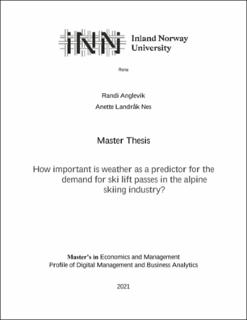| dc.description.abstract | This thesis aims to examine and interpret the importance of weather variables as predictors for
demand in the Norwegian alpine skiing industry. A specific skiing facility has provided a unique
data set, containing their daily sales data from the winter seasons of 2014/2015 to 2019/2020. The
sales data is used in combination with simulated weather forecast data to develop linear regression
forecast models. The predictive performance of the models is compared statistically to analyse the
importance of weather variables for predictive accuracy. The main findings show that the
importance of temperature, snow depth and precipitation for predictive purposes is low. Seasonal
variables, such as day of the week and public holidays, appears to be of greater importance as
predictors of demand. The authors find no statistically significant improvement in the predictive
ability of models with weather variables compared to models without. | en_US |
